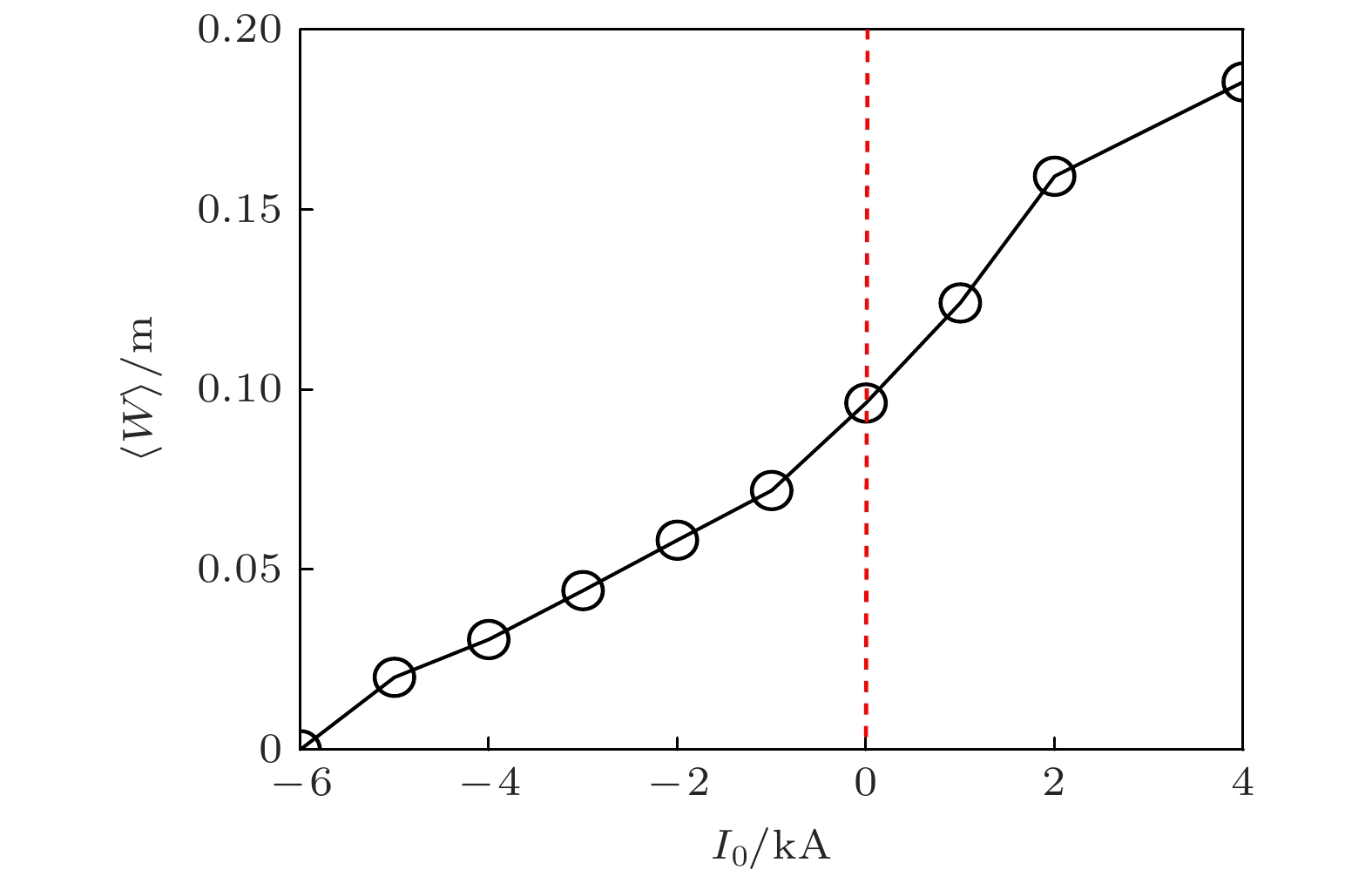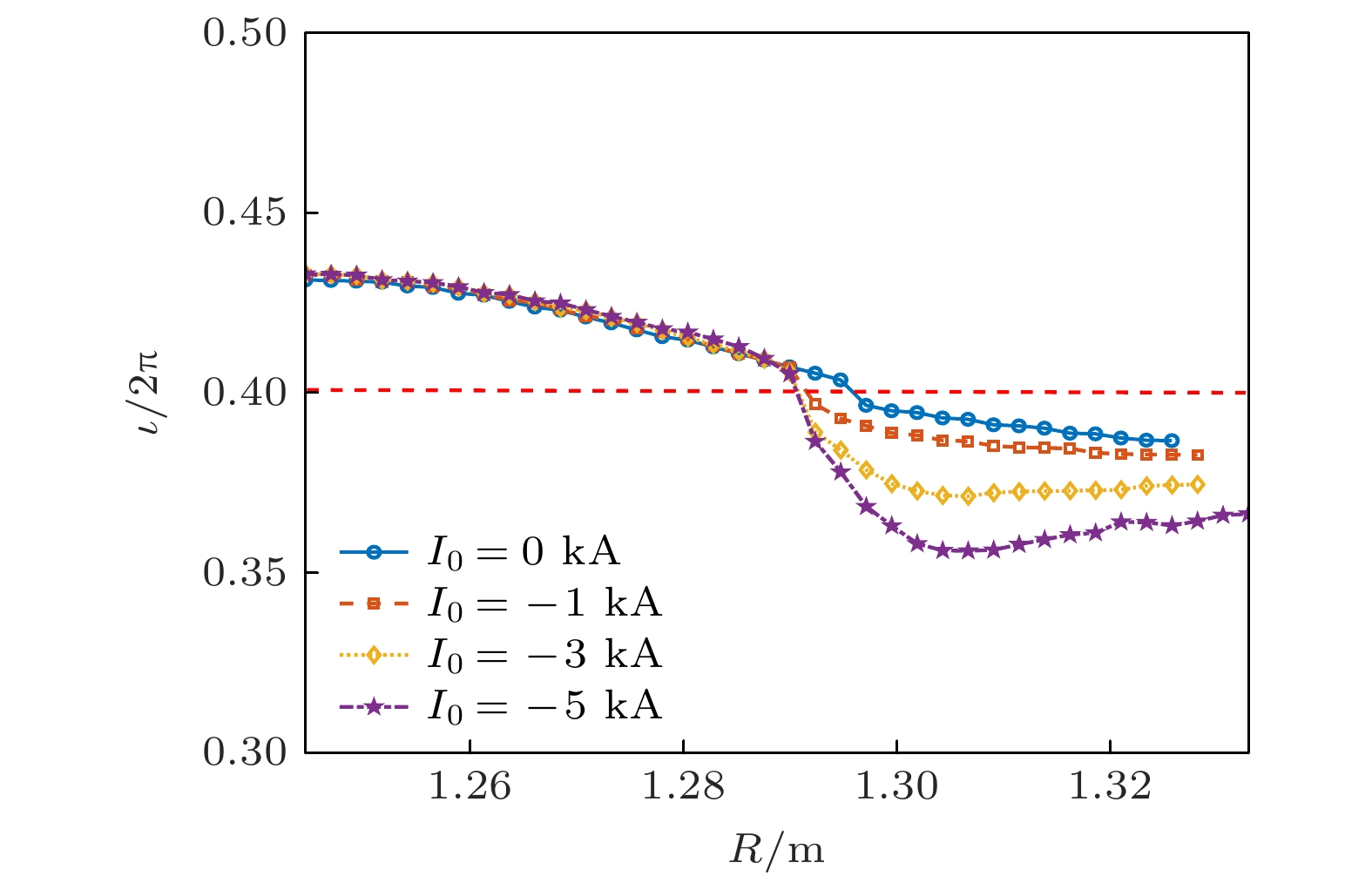-
Magnetic island produced in toroidal magnetic confinement plasma has a three-dimensional helical structure because of the rotational transform, especially the equilibrium magnetic surface of the stellarator is three-dimensional helical structure. Thus, the formation and instability of the magnetic island of the Stellarator is a typical issue of the three-dimensional physics and is also one of the key topics of the physics research of the Stellarator. Magnetic islands and related tearing mode physics are major issues in stellarator. The non-inductively current drive, i.e. electron cyclotron current drive (ECCD) can be used as one of the approaches to adjusting the rotational transform, and hence, affecting the generation of magnetic islands. In this study, we use an additional toroidal magnetic field to generate m/n = 5/2 magnetic islands in the low-β operation on the Chinese First Quasi-axisymmetric Stellarator (CFQS) so that the influence of the bootstrap current is negligible. Then, we investigate the suppression mechanism of magnetic islands in low-β plasma by using the HINT code. It is found that in the case of the constant current, when the current direction is positive, with the increase of current, the width of island increases. When the direction of current is reversed, the island is suppressed when the current is larger than 6 kA. The main reason is that the rotational transform is away from ι/2π = 0.4 rational surface and the m/n=5/2 magnetic island does not meet the resonance conditions. In the case of local current profile, the magnetic island width decreases as a result of the enhanced magnetic shear at ι/2π = 0.4 rational surface. Moreover, effects of the direction and the amplitude of the current on the suppression of magnetic islands are also discussed in more detail.
[1] ITER Physics Expert Group on Disruptions, Plasma Control, MHD and ITER Physics Basis Editors 1999 Nucl. Fusion 39 2251
 Google Scholar
Google Scholar
[2] Boozer A H 2012 Phys. Plasmas 19 058101
 Google Scholar
Google Scholar
[3] Hirsch M, Baldzuhn J, Beidler C, Brakel R, Burthenn R, Dinklage A, Ehmler H, Endler M, Erckmann V, Feng Y 2008 Plasma Phys. Control. Fusion 50 053001
 Google Scholar
Google Scholar
[4] Yamada H, Kawahata K, Mutoh T, et al. 2010 Fusion Sci. Technol. 58 12
 Google Scholar
Google Scholar
[5] Garabedian P R 1996 Phys. Plasmas 3 2483-2485.
 Google Scholar
Google Scholar
[6] Xu Y 2016 Matter and Radiation at Extremes 1 192
 Google Scholar
Google Scholar
[7] Nemov V V, Isobe M, Kernbichler W, et al. 2003 Plasma Phys. Controlled Fusion 45 1829
 Google Scholar
Google Scholar
[8] Okamura S, Murakmi S, Shimizu A, et al. 2000 J. Plasma Fusion Res. SERIES 3 73
[9] Okamura S, Matsuoka K, Nishimura S, et al. 2001 Nucl. Fusion 41 1865
 Google Scholar
Google Scholar
[10] Matsuoka K, Okamura S, Nishimura S, et al. 2004 Fusion Sci. Technol. 46 378
 Google Scholar
Google Scholar
[11] Okamura S, Matsuoka K, Nishimura S, et al. 2004 Nucl. Fusion 44 575
 Google Scholar
Google Scholar
[12] Reiman A, Ku L, Monticello D, et al. 2001 Phys. Plasmas 8 2083
 Google Scholar
Google Scholar
[13] Reiman A, Fu G, Hirshman S, et al. 1999 Plasma Phys. Controlled Fusion 41 B273
 Google Scholar
Google Scholar
[14] Neilson G H, Reiman A H, Zarnstorff M C, et al. 2000 Phys. Plasmas 7 1911
 Google Scholar
Google Scholar
[15] Zarnstorff M C, Berry L A, Brooks A, et al. 2001 Plasma Phys. Controlled Fusion 43 A237
 Google Scholar
Google Scholar
[16] Xu Y, Shimizu A, Liu B, et al. 2018 27th IAEA Fusion Energy Conference Gandhinagar, India, October 22–27, 2018, EX/P5-23
[17] 黄捷, 李沫杉, 覃程, 王先驱 2022 71 185202
 Google Scholar
Google Scholar
Huang J, Li M S, Qin C, Wang X Q 2022 Acta Phys. Sin 71 185202
 Google Scholar
Google Scholar
[18] Su C Y, Chen S Y, Liu H F, et al. 2020 AIP Adv. 10 015004
 Google Scholar
Google Scholar
[19] Harafuji K, Hayashi T, Sato T 1989 J. Comput. Phys. 81 169
 Google Scholar
Google Scholar
[20] Hirshman S P, Whitson J C. 1983 Phys. Fluids 26 3553
 Google Scholar
Google Scholar
[21] Suzuki Y 2017 Plasma Phys. Control. Fusion 59 054008
 Google Scholar
Google Scholar
[22] Suzuki Y 2020 Plasma Phys. Control. Fusion 62 104001
 Google Scholar
Google Scholar
[23] Suzuki Y, Nakajima N, Watanabe K, et al. 2006 Nucl. Fusion 46 L19
 Google Scholar
Google Scholar
[24] Liu H F, Shimizu A, Isobe M, et al. 2018 Plasma Fusion Res. 13 3405067
 Google Scholar
Google Scholar
[25] Liu H F, Shimizu A, Xu Y, et al. 2021 Nucl. Fusion 61 016014
 Google Scholar
Google Scholar
[26] Shimizu A, Liu H F, Isobe M, et al. 2018 Plasma Fusion Res. 13 3403123
 Google Scholar
Google Scholar
[27] Wang X Q, Xu Y, Shimizu A, et al. 2021 Nucl. Fusion 61 036021
 Google Scholar
Google Scholar
[28] Wesson J, Campbell D J, Connor J W, et al. 2004 Tokamaks (3rd Ed.) (New York: Oxford University Press) pp358–359
[29] Isayama A 2006 Plasma Sci. Technol. 8 36
 Google Scholar
Google Scholar
-
图 1 (a)
$\left\langle \beta \right\rangle = 0.5{\text{%}} $ 时旋转变换以及压强的径向分布; (b)$\left\langle \beta \right\rangle = 0.5{\text{%}} $ 、环向角$\phi = {0^ \circ }$ 时所对应的初始庞加莱图. 黑色点表示$p/{p_0} < 1{\text{%}} $ 的区域, 蓝色点表示$1{\text{%}} \leqslant $ $ p/{p_0} \leqslant 10{\text{%}} $ 的区域, 红色点表示$p/{p_0} > 10{\text{%}} $ 的区域, 绿色线为真空室Figure 1. (a) Comparison of the radial dependence of the rotational transform and pressure,
$\iota /2\pi $ with$\left\langle \beta \right\rangle = 0.5{\text{%}} $ , between the HINT and VMEC codes; (b) the Poincaré plots of initial magnetic surfaces with$\left\langle \beta \right\rangle = 0.5{\text{%}} $ at toroidal angle$\phi = {0^ \circ }$ , where the black, blue and red colors mark the regions of$p/{p_0} < 1{\text{%}} $ ,$1{\text{%}} \leqslant p/{p_0} \leqslant 10{\text{%}} $ , and$p/{p_0} > $ $ 10{\text{%}} $ , respectively. The green line denotes the boundary of the vacuum vessel.图 4 (a)—(c)
$ {I}_{0}=2, \text{ }4, \text{ }6\text{ kA} $ 时庞加莱磁面; (d)—(f) 为$ {I}_{0}=-2, \text{ }-4, \text{ }-6\text{ kA} $ 时庞加莱磁面Figure 4. (a)–(c) Poincaré plots of magnetic surfaces with
$ {I}_{0}=2, \text{ }4, \text{ }6\text{ kA} $ ; (d)–(f) the Poincaré plots of magnetic surfaces with$ {I}_{0}=-2, \text{ }-4, \text{ }-6\text{ kA} $ . -
[1] ITER Physics Expert Group on Disruptions, Plasma Control, MHD and ITER Physics Basis Editors 1999 Nucl. Fusion 39 2251
 Google Scholar
Google Scholar
[2] Boozer A H 2012 Phys. Plasmas 19 058101
 Google Scholar
Google Scholar
[3] Hirsch M, Baldzuhn J, Beidler C, Brakel R, Burthenn R, Dinklage A, Ehmler H, Endler M, Erckmann V, Feng Y 2008 Plasma Phys. Control. Fusion 50 053001
 Google Scholar
Google Scholar
[4] Yamada H, Kawahata K, Mutoh T, et al. 2010 Fusion Sci. Technol. 58 12
 Google Scholar
Google Scholar
[5] Garabedian P R 1996 Phys. Plasmas 3 2483-2485.
 Google Scholar
Google Scholar
[6] Xu Y 2016 Matter and Radiation at Extremes 1 192
 Google Scholar
Google Scholar
[7] Nemov V V, Isobe M, Kernbichler W, et al. 2003 Plasma Phys. Controlled Fusion 45 1829
 Google Scholar
Google Scholar
[8] Okamura S, Murakmi S, Shimizu A, et al. 2000 J. Plasma Fusion Res. SERIES 3 73
[9] Okamura S, Matsuoka K, Nishimura S, et al. 2001 Nucl. Fusion 41 1865
 Google Scholar
Google Scholar
[10] Matsuoka K, Okamura S, Nishimura S, et al. 2004 Fusion Sci. Technol. 46 378
 Google Scholar
Google Scholar
[11] Okamura S, Matsuoka K, Nishimura S, et al. 2004 Nucl. Fusion 44 575
 Google Scholar
Google Scholar
[12] Reiman A, Ku L, Monticello D, et al. 2001 Phys. Plasmas 8 2083
 Google Scholar
Google Scholar
[13] Reiman A, Fu G, Hirshman S, et al. 1999 Plasma Phys. Controlled Fusion 41 B273
 Google Scholar
Google Scholar
[14] Neilson G H, Reiman A H, Zarnstorff M C, et al. 2000 Phys. Plasmas 7 1911
 Google Scholar
Google Scholar
[15] Zarnstorff M C, Berry L A, Brooks A, et al. 2001 Plasma Phys. Controlled Fusion 43 A237
 Google Scholar
Google Scholar
[16] Xu Y, Shimizu A, Liu B, et al. 2018 27th IAEA Fusion Energy Conference Gandhinagar, India, October 22–27, 2018, EX/P5-23
[17] 黄捷, 李沫杉, 覃程, 王先驱 2022 71 185202
 Google Scholar
Google Scholar
Huang J, Li M S, Qin C, Wang X Q 2022 Acta Phys. Sin 71 185202
 Google Scholar
Google Scholar
[18] Su C Y, Chen S Y, Liu H F, et al. 2020 AIP Adv. 10 015004
 Google Scholar
Google Scholar
[19] Harafuji K, Hayashi T, Sato T 1989 J. Comput. Phys. 81 169
 Google Scholar
Google Scholar
[20] Hirshman S P, Whitson J C. 1983 Phys. Fluids 26 3553
 Google Scholar
Google Scholar
[21] Suzuki Y 2017 Plasma Phys. Control. Fusion 59 054008
 Google Scholar
Google Scholar
[22] Suzuki Y 2020 Plasma Phys. Control. Fusion 62 104001
 Google Scholar
Google Scholar
[23] Suzuki Y, Nakajima N, Watanabe K, et al. 2006 Nucl. Fusion 46 L19
 Google Scholar
Google Scholar
[24] Liu H F, Shimizu A, Isobe M, et al. 2018 Plasma Fusion Res. 13 3405067
 Google Scholar
Google Scholar
[25] Liu H F, Shimizu A, Xu Y, et al. 2021 Nucl. Fusion 61 016014
 Google Scholar
Google Scholar
[26] Shimizu A, Liu H F, Isobe M, et al. 2018 Plasma Fusion Res. 13 3403123
 Google Scholar
Google Scholar
[27] Wang X Q, Xu Y, Shimizu A, et al. 2021 Nucl. Fusion 61 036021
 Google Scholar
Google Scholar
[28] Wesson J, Campbell D J, Connor J W, et al. 2004 Tokamaks (3rd Ed.) (New York: Oxford University Press) pp358–359
[29] Isayama A 2006 Plasma Sci. Technol. 8 36
 Google Scholar
Google Scholar
Catalog
Metrics
- Abstract views: 7328
- PDF Downloads: 211
- Cited By: 0































 DownLoad:
DownLoad:
































